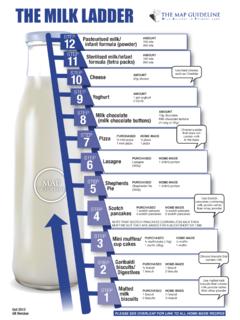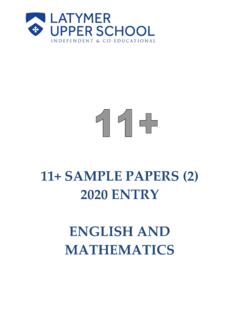Transcription of LACTOSE INTOLERANCE AND COWS’ MILK PROTEIN …
1 Note: Patients who are not eligible for treatment under this statement may be considered on an individual basis where their GP or consultant believes exceptional circumstances exist that warrant deviation from the rule of this policy. In this situation, follow locally defined processes. APC board date: 28 Jul 2021 | Last updated: 28 Jul 2021 Prescribing guideline Review date: Jul 2024 (or earlier if there is significant new evidence relating to this recommendation) Version: APC administration provided by Midlands and Lancashire Commissioning Support Unit With acknowledgement to North West Paediatric Allergy Network, Alder Hey Children's NHS Foundation Trust WL Wa Ha SH This policy statement is approved by Halton, Knowsley, Liverpool, South Sefton, Southport and Formby, St Helens, Warrington, West Lancashire.
2 And Wirral CCGs Kn Li SF SS Wi LACTOSE INTOLERANCE AND COWS milk PROTEIN ALLERGY Prescribing Guidelines for Specialist Infant Formula Feeds This guidance outlines recommendations for the prescribing of infant formula feeds in cows milk PROTEIN allergy (CMPA) and LACTOSE INTOLERANCE . GUIDELINE INTRODUCTION Cows milk PROTEIN allergy is an immune-mediated allergic response to proteins in milk . It can be immediate in onset following consumption when it is caused by immunoglobulin E antibodies IgE mediated. When the presentation is delayed by hours or even days following exposure, it is called non-immunoglobulin E mediated or non-IgE mediated reaction.
3 LACTOSE INTOLERANCE occurs when there is reduced or absence of the enzyme lactase. Lactase is present in the lining of the small intestine. Low levels of this enzyme prevent the effective digestion of LACTOSE sugar and results in loose acidic stools. The undigested LACTOSE sugar arrives into the large intestines where it ferments to produce gas and mild acid that causes discomfort and flatulence. This guidance covers all infants; including those who breastfeed, who are formula-fed or those who do a combination of both. The objectives of this guidance are to: Aid diagnosis and improve access to special infant formula where needed, minimising distress to the baby and anxiety to the parents/carers.
4 Provide guidance on the nature, prescribing and cost effective supply of milk substitutes for babies. Provide advice on suitable quantities for prescribing, duration of supply and guidance on stopping prescribing. Maintaining awareness that breast milk is considered best for babies and not initiating a change from breast to formula milk if the mother is happy to continue breastfeeding the infant. This guidance should be used in conjunction with: - NICE Clinical Guideline 116, Food allergy in children and young people: Diagnosis and assessment of food allergy in children and young people in primary care and community settings, - NICE Clinical Knowledge Summaries Cow s milk PROTEIN allergy in children (June 2015) 2 EXCLUSION: Secondary care will lead in prescribing of other specialist infant formula for several special groups of infants such as.
5 Pre-term and low birth weight infants (may also require iron and vitamin supplements) Disease specific conditions Complex IgE and non-IgE mediated food allergies Faltering growth Complex medical cases Cystic fibrosis and these are outside of the scope of this guidance. 1. KEY MESSAGES Cows milk PROTEIN allergy: Breastfeeding is the best form of nutrition for infants and this should be promoted, supported and protected wherever possible. This includes infants under investigation or with confirmed CMPA. Infants requiring specialist milks other than those for LACTOSE INTOLERANCE should be managed as per Flow Chart 3, Page 4 - The initial management of cows milk PROTEIN allergy (CMPA) and Flow Chart 4, Page 5 - On-going management of CMPA following exclusion diet.
6 Referrals to infant feeding clinic, dietitian and/or paediatrician should be made in accordance with local pathways. Most children with CMPA will have developed some tolerance to cows milk PROTEIN by the age of Any child still prescribed specialist formula by 2 years of age should be weaned onto supermarket bought milk alternative calcium enriched soya milk or oat milk . Prescription formula should no longer be required by 2 years. Prescribe only enough tins for 1 week initially until compliance/patient acceptability is established to avoid waste. Only add infant formulae to the repeat prescribing template in primary care if a review process is established to ensure the correct product and quantity is prescribed for the age of the infant.
7 See Section 7, Page 8 for more detail on quantities to prescribe. Soya products should not be recommended first line unless advised by a paediatric consultant or dietitian due to the high incidence of soya sensitivity (10-35%) in infants intolerant of cows milk PROTEIN , and never for infants under 6 months of age unless on specialist advice for galactosaemia. Infants of vegan mothers who choose not to breastfeed should not receive soya formula on the NHS as products are available at the same cost as standard formula. LACTOSE INTOLERANCE : In general, all cases of milk INTOLERANCE should be referred for specialist dietetic advice with the exception of simple cases of secondary LACTOSE INTOLERANCE , for which a LACTOSE free formula should be advised, and a re-challenge carried out after 8 weeks.
8 If symptoms recur after re-challenge consider referral to general paediatrics. LACTOSE free formula can be bought at an only slightly higher cost to standard infant formula, and prescribers should not routinely prescribe. These have no role in the management of cows milk allergy. Parents can purchase LACTOSE free formula from their chosen retailer; however they are less commonly used than standard formula and may have to be ordered. Most pharmacies and many supermarkets can obtain stock in a few days. 3 3. The initial management of cows milk PROTEIN allergy (CMPA) One or more of these symptoms (usually acute) Vomiting Diarrhoea Abdominal pain / colic Acute pruritus, erythema, urticarial Angioedema Acute flare up of atopic eczema Anaphylaxis / Severe symptoms IMMEDIATE A&E REFERRAL URGENT TREATMENT for Respiratory cough, wheeze, voice change or breathing difficulty CVS faint, floppy, pale, collapsed from low blood pressure Or recurrent GI symptoms One or more of these symptoms (usually non acute)
9 Severe colic Vomiting Reflux Bottle refusal or aversion Loose or frequent stools Perianal redness Constipation Abdominal discomfort Blood / mucus in stools (in an otherwise well infant) Pruritus, erythema Significant atopic eczema Acute onset (IgE-mediated) generally within the hour, rarely delayed (Minority of cases) Yes No Signs of faltering growth Delayed onset (Non-IgE-mediated) generally within 2 72 hours (Majority of cases) Signs of faltering growth BOX 1: Formula fed Trial of extensively hydrolysed formula (EHF)* see section BOX 3: Exclusively breastfed Refer to infant feeding lead for breastfeeding assessment prior to prescribing Exclude cows milk containing foods from maternal diet for 2 4 weeks and continue breastfeeding Prescribe for mother: Calcichew D3 Forte chewable tablets 2 daily If mothers do not wish to or are unable to follow a milk free diet prescribe EHF, If mother is following a milk free diet and symptoms persist, prescribe amino acid formula (AAF) as top-up if needed NB Breastmilk may take 1-2 weeks to become truly dairy free from the initiation of maternal exclusion diet.
10 REFER to a specialist for a skin prick and/or specific IgE antibody blood test TREAT as per Box 1, 2 or 3 below whilst waiting for referral appointment. URGENTLY TREAT symptoms IMMEDIATE REFERRAL to specialist * LACTOSE containing EHF may be more palatable babies over 6 months who don t like the taste of standard EHF LACTOSE -free products. Note: Some infants with CMPA have a mixed delayed and acute presentation. Treatment should follow the guidance for acute in these cases. BOX 2: Mixed-fed Trial of cows milk free maternal diet with EHF top-ups if needed For formula fed, mixed-fed and exclusively breast fed infants.








